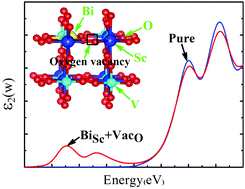The role of oxygen defects in a bismuth doped ScVO4 matrix: tuning luminescence by hydrogen treatment
Abstract
We have investigated the mechanism of tunable luminescence in a bismuth doped ScVO4 matrix by using the first-principles calculations. It is found that some intrinsic defects generally exist in the matrix due to their low formation energies, while they have no remarkable effect in the optical band gap of the compound. The calculated formation energy of substitutional Bi at the Sc site is 2.0–3.3 eV lower than that of replacing V by Bi in various chemical environments. Yet, once there is an oxygen defect (vacancy) around a Bi atom, it is energetically preferable to form a defect complex, BiSc + VacO. Based on the calculated formation energy and the imaginary part of the dielectric function, the defect complex transfers between the neutral charge state and the 1+ charge state, which is ascribed to be responsible for the red bismuth photoemission observed in experiment. With the defect complex, tunable bismuth photoemission could be achieved by selectively controlling the content of hydrogen. Our calculations have shown that there is a passivation effect resulting from the re-padding of the oxygen defect by the hydrogen atom. This confirms the experimental observation of tunable bismuth luminescence due to the defect complex, leading to a potential facile design of other defect-controllable, micro- and nano-sized luminescent materials ranging from the visible to the near- and far-infrared spectrum.


 Please wait while we load your content...
Please wait while we load your content...